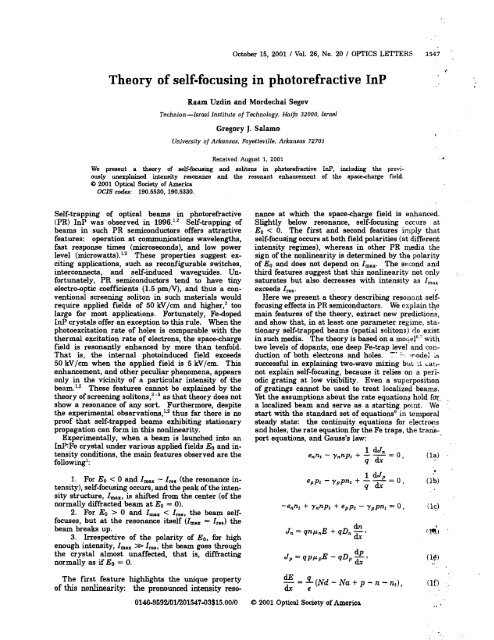Three - University of Arkansas Physics Department
Three - University of Arkansas Physics Department
Three - University of Arkansas Physics Department
Create successful ePaper yourself
Turn your PDF publications into a flip-book with our unique Google optimized e-Paper software.
October 15, 2001 / Vol. 26, No. 20 / OPTICS LETTERS 1547 .<br />
Theory <strong>of</strong> self-focusing in photorefractive InP<br />
Raam Uzdin and Mordechai Segev<br />
Technion-Israel Institute <strong>of</strong> Technology, Haifa 32000, Israel<br />
Gregory J. Salamo<br />
<strong>University</strong> <strong>of</strong> <strong>Arkansas</strong>, Fayetteville. <strong>Arkansas</strong> 72701<br />
Received August 1. 2001 . ><br />
We present a theory <strong>of</strong> self-focusing and solitons in photorefractive InP, including the previously<br />
unexplained intensity resonance and the resonant enhancement <strong>of</strong> the spacecharge field.<br />
O 2001 Optical Society <strong>of</strong> America<br />
OCIS codes: 190.5530, 190.5330.<br />
Self-trapping <strong>of</strong> optical beams in photorefractive<br />
(PR) InP was observed in 1996.1a2 Self-trapping <strong>of</strong><br />
beams in such PR semicondudors <strong>of</strong>fers attractive<br />
features: operation at communications wavelengths,<br />
fast response times (microseconds), and low power<br />
level micro watt^).'^^ These properties suggest exciting<br />
applications, such as reconfigurable switches,<br />
interconnects, and self-induced waveguides. Unfortunately,<br />
PR semicondudors tend to have tiny<br />
electrogptic coefficients (1.5 pm/V), and thus a conventional<br />
screening soliton in such materials would<br />
require applied fields <strong>of</strong> 50 kV/cm and higher,3 too<br />
large for most applications. Fortunately, Fedoped<br />
InP crystals <strong>of</strong>fer an exception to this rule. When the<br />
photoexcitation rate <strong>of</strong> holes is comparable with the<br />
thermal excitation rate <strong>of</strong> electrons, the spacecharge<br />
field is resonantly enhanced by more than tenfold.<br />
That is, the internal photoinduced field exceeds<br />
50 kV/cm when the applied field is 5 kV/cm. This<br />
enhancement, and other peculiar phenomena, appears<br />
only in the vicinity <strong>of</strong> a particular intensity <strong>of</strong> the<br />
beam.',' These features cannot be explained by the<br />
theory <strong>of</strong> screening soliton^,^-^ as that theory does not<br />
show a resonance <strong>of</strong> any sort. Furthermore, despite<br />
the experimental ob~ervations,'.~ thus far there is no<br />
pro<strong>of</strong> that self-trapped beams exhibiting stationary<br />
propagation can form in this nonlinearity.<br />
Experimentally, when a beam is launched into an<br />
W:Fe crystal under various applied fields Eo and intensity<br />
conditions, the main features observed are the<br />
following1:<br />
nance at which the spacecharge field is enhanced.<br />
Slightly below resonance, self-focusing occurs at<br />
Eo < 0. The first and second features inlply that<br />
self-focusing occurs at both field polarities (at different<br />
intensity regimes), whereas in other PR media the<br />
sign <strong>of</strong> the nonlinearity is determined by the polarity<br />
<strong>of</strong> Eo and does not depend on I,,,. The second and<br />
third features suggest that this nonlinearity not only<br />
saturates but also decreases with intensity as I,,,<br />
exceeds I,,.<br />
Here we present a theory describing resonant selffocusing<br />
effects in PR semiconductors. We explain the<br />
main features <strong>of</strong> the theory, extract new predictions,<br />
and show that, in at least one parameter regime, stationary<br />
self-trapped beams (spatial solitons) do exist<br />
in such media. The theory is based on a moc;e16 with<br />
two levels <strong>of</strong> dopants, one deep Fe-trap level and conduction<br />
<strong>of</strong> both electrons and holes. " :. ~rlode; ,><br />
successful in explaining two-wave mixi~ig bu~<br />
:i Lartnot<br />
explain self-focusing, because it relies on a periodic<br />
grating at low visibility. Even a superposition<br />
<strong>of</strong> gratings cannot be used to treat localized beams.<br />
Yet the assumptions about the rate equations hold fq<br />
a localized beam and serve as a starting polnt. We<br />
start with the standard set <strong>of</strong> equations6 in temporal<br />
steady state: the continuity equations for electrons<br />
and holes, the rate equation for the Fe traps, the trane-,<br />
port equations, and Gauss's law:<br />
1. For Eo < 0 and I,., - I,,. (the resonance intensity),<br />
self-focusing occurs, and the peak <strong>of</strong> the intensity<br />
structure, I,,,, is shifted from the center (<strong>of</strong> the<br />
normally diffracted beam at Eo = 0).<br />
2. For EO > 0 and I,., < I,., the beam selffocuses,<br />
but at the resonance itself (I,, = I,,,) the<br />
beam breaks up.<br />
3. Irrespective <strong>of</strong> the polarity <strong>of</strong> Eo, for high<br />
enough intensity, I,,, >> I,,,, the beam goes through<br />
the crystal almost unaffected, that is, diffracting<br />
normally as if Eo = 0.<br />
The first feature highlights the unique property<br />
<strong>of</strong> this nonlinearity: the pronounced intensity reso-<br />
0146.9592/01/201547-03$15.0010 63 2001 Optical Society <strong>of</strong> America ., :













